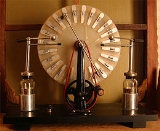
Wimshurst machine
Overview
Electrostatic generator
An electrostatic generator, or electrostatic machine, is a mechanical device that produces static electricity, or electricity at high voltage and low continuous current...
, a machine for generating high voltage
Voltage
Voltage, otherwise known as electrical potential difference or electric tension is the difference in electric potential between two points — or the difference in electric potential energy per unit charge between two points...
s developed between 1880 and 1883 by British
United Kingdom
The United Kingdom of Great Britain and Northern IrelandIn the United Kingdom and Dependencies, other languages have been officially recognised as legitimate autochthonous languages under the European Charter for Regional or Minority Languages...
inventor James Wimshurst
James Wimshurst
James Wimshurst was an English inventor, engineer and shipwright. Though Wimshurst did not patent his machines and the various improvements that he made to them, his refinements to the electrostatic generator led to its becoming widely known as the Wimshurst machine.-Biography:Wimshurst was born...
(1832 – 1903).
It has a distinctive appearance with two large contra-rotating discs mounted in a vertical plane, two cross bars with metallic brushes, and a spark gap
Spark gap
A spark gap consists of an arrangement of two conducting electrodes separated by a gap usually filled with a gas such as air, designed to allow an electric spark to pass between the conductors. When the voltage difference between the conductors exceeds the gap's breakdown voltage, a spark forms,...
formed by two metal spheres.
These machines belong to a class of generators called influence machines, which separate electric charge
Electric charge
Electric charge is a physical property of matter that causes it to experience a force when near other electrically charged matter. Electric charge comes in two types, called positive and negative. Two positively charged substances, or objects, experience a mutual repulsive force, as do two...
s through electrostatic induction
Electrostatic induction
Electrostatic induction is a redistribution of electrical charge in an object, caused by the influence of nearby charges. Induction was discovered by British scientist John Canton in 1753 and Swedish professor Johan Carl Wilcke in 1762. Electrostatic generators, such as the Wimshurst machine, the...
, or influence.

